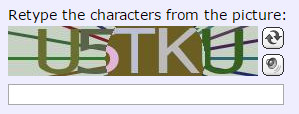How To Add BotDetect CAPTCHA Protection to JSP Forms
Protecting your JSP forms with BotDetect Java Captcha requires a few steps, outlined on this page. Displaying the Captcha challenge can be as simple as:
<% // Adding BotDetect Captcha to the page Captcha captcha = Captcha.load(request, "exampleCaptcha"); captcha.setUserInputID("captchaCode"); String captchaHtml = captcha.getHtml(); out.write(captchaHtml); %> <input id="captchaCode" type="text" name="captchaCode" />
and checking user input when the form is submitted:
boolean isHuman = captcha.validate(request.getParameter("captchaCode"));
First Time Here?
Check the BotDetect JSP Captcha Quickstart for key integration steps.
You can also see how BotDetect Captcha protection has been added to various kinds of JSP forms and projects by running the BotDetect Captcha JSP integration code examples coming with the BotDetect installation. You can also reuse the code example source code that fits your requirements.
CAPTCHA Integration Steps
To add BotDetect Captcha protection to a JSP application:
- Add BotDetect library in the classpath
- Register
CaptchaServlet - Display Captcha protection on the JSP form
- Validate Captcha user input during JSP form submission
Add BotDetect Java CAPTCHA Library Dependency
Here is how to add BotDetect Java CAPTCHA Library dependency in various dependency management scenarios:
Install BotDetect Java CAPTCHA dependencies
The free version Maven artifacts are available from our public repository; while the enterprise version jars are available in the root folder of the enterprise version's archive.
To reference the BotDetect dependency from our public repository, the repository itself has to be declared first -- add the highlighted lines
to your app's pom.xml file:
<repository> <id>captcha</id> <name>BotDetect Captcha Repository</name> <url>https://git.captcha.com/botdetect-java-captcha.git/blob_plain/HEAD:/</url> </repository>
Then, in the same file, declare the BotDetect dependency, too:
<dependency> <groupId>com.captcha</groupId> <artifactId>botdetect-jsp20</artifactId> <version>4.0.beta3.7</version> </dependency>
Register CaptchaServlet
Update your application configuration (web.xml) file.
<servlet> <servlet-name>BotDetect Captcha</servlet-name> <servlet-class>com.captcha.botdetect.web.servlet.CaptchaServlet</servlet-class> </servlet> <servlet-mapping> <servlet-name>BotDetect Captcha</servlet-name> <url-pattern>/botdetectcaptcha</url-pattern> </servlet-mapping>
Display Captcha Protection on the JSP Form
We'll assume you already have a form which can be posted (<form method="post" ...), with other fields in place.
This approach is especially useful when <form> tag has no action attribute since Captcha object will already be instantiated for validation.
First, on the top of the JSP form source file add:
<%@page import="com.captcha.botdetect.web.servlet.Captcha"%>
To display the Captcha test on your form, you will need the following Html elements:
- A textbox for the Captcha code user input, with a label displaying Captcha instructions
- The Captcha markup including the image, sound and reload icons etc., which will be generated by the Captcha library
For example:
<label for="captchaCode" class="prompt"> Retype the characters from the picture:</label> <% // Adding BotDetect Captcha to the page Captcha captcha = Captcha.load(request, "exampleCaptcha"); captcha.setUserInputID("captchaCode"); String captchaHtml = captcha.getHtml(); out.write(captchaHtml); %> <input id="captchaCode" type="text" name="captchaCode" />
The JSP scriptlet above creates a new instance of the Captcha class defined by the BotDetect Java Captcha library, tells it which textbox is used to input Captcha codes (default is captchaCode), and calls the getHtml() method to generate all needed BotDetect Html elements.
When you open your form in a browser, the above declarations should render as:

If you are adding Captcha protection to multiple JSP forms in the same website, you should initialize each Captcha object with unique name (e.g. "registrationCaptcha", "commentCaptcha", ...).
Validate Captcha User Input During JSP Form Submission
Since we want to ensure only real human users can perform a certain action (e.g. account registration or comment submission), we also have to add Captcha validation code which will process form submissions, and only allow certain actions if Captcha validation succeeds.
Form Has No Action
In the simplest case (when the form posts to itself, i.e. the action attribute is not set), you will process form submissions on the form itself:
<% if ("POST".equalsIgnoreCase(request.getMethod())) { boolean isHuman = captcha.validate(request.getParameter("captchaCode")); if (isHuman) { // TODO: Captcha validation passed, perform protected action } else { // TODO: Captcha validation failed, show error message } } %>
The above code is very simple:
- The
if ("POST".equalsIgnoreCase(request.getMethod())) {line ensures the code only runs when the form is submitted. - The
boolean isHuman = captcha.validate( request.getParameter("captchaCode"));line calls thevalidate(String userInput)method of theCaptchaobject, which returnstrueif the submitted Captcha code matches the one used for Captcha image generation, orfalseotherwise.
This approach is shown in the BotDetect basic JSP integration code example included in the BotDetect download package.
Separate Servlet Processing Action
If your form posts to a separate servlet, you can use the same Captcha validation code. You just have to create Captcha object instance with the same name as the one used on the form first:
Captcha captcha = Captcha.load(request, "exampleCaptcha"); // validate the Captcha to check we're not dealing with a bot boolean isHuman = captcha.validate(request.getParameter("captchaCode")); if (isHuman) { // TODO: Captcha validation passed, perform protected action } else { // TODO: Captcha validation failed, show error message } RequestDispatcher dispatcher = getServletContext().getRequestDispatcher("/index.jsp"); dispatcher.forward(request, response);
In this trivial case response is redirected back to original form.
This approach is shown in the BotDetect JSP Captcha Tag integration code example included in the BotDetect download package.
Please Note
BotDetect Java Captcha Library v4.0.Beta3.7 is an in-progress port of BotDetect 4 Captcha, and we need you to guide our efforts towards a polished product. Please let us know if you encounter any bugs, implementation issues, or a usage scenario you would like to discuss.
Current BotDetect Versions
-
BotDetect ASP.NET CAPTCHA
2019-07-22v4.4.2 -
BotDetect Java CAPTCHA
2019-07-22v4.0.Beta3.7 -
BotDetect PHP CAPTCHA
2019-07-22v4.2.5












